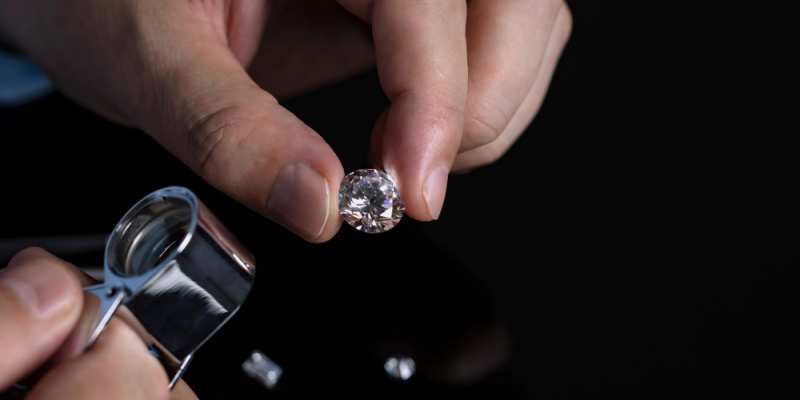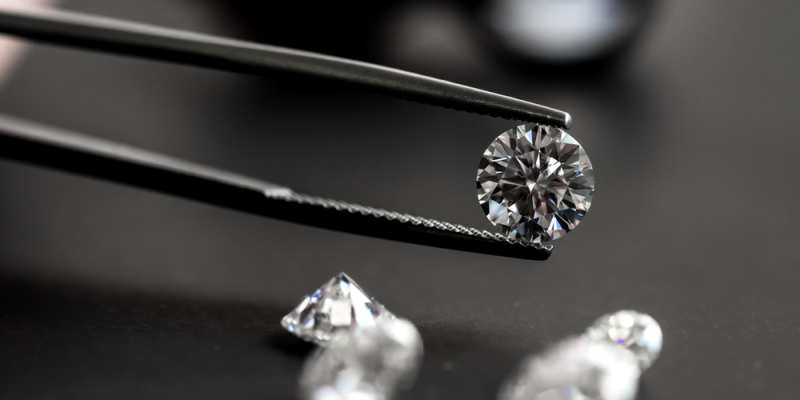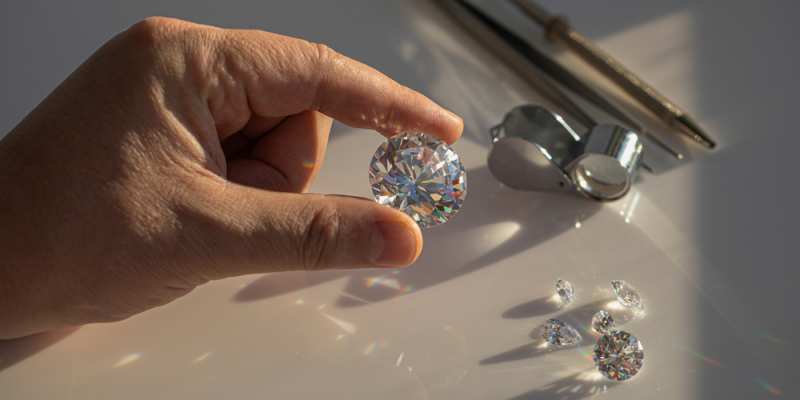Diamonds are renowned for their exceptional beauty and unmatched hardness. However, despite their durability, diamonds are not indestructible. There are various ways in which a diamond can be damaged. One question that arises is whether shining UV light on a diamond is one such way. Can ultraviolet light destroy a diamond?
Today, we will explore this question and provide an interesting answer. Technically speaking, yes, UV light can have a detrimental effect on a diamond. However, it is important to understand what exactly happens when a diamond is exposed to UV light. Does this mean you should shield your diamond ring from sunlight?
In this article, we will delve into the topic of diamonds versus UV light and provide you with all the information you need. Let the exploration begin!
DESIGN YOUR OWN ENGAGEMENT RING: START WITH A SETTING OR START WITH A DIAMOND. IT’S REALLY UP TO YOU!

Diamond’s Description
Diamonds possess a distinct and remarkable crystal structure and composition, setting them apart as unique representatives of the mineral kingdom.
Unlike other precious stones, diamonds are composed of a single element. Typically, diamonds consist of 99.95% carbon, with the remaining 0.05% potentially containing trace elements. While these trace elements do not form an essential part of a diamond’s chemistry, they can influence its color, shape, and other properties.
The formation process of diamonds plays a crucial role in defining their identity. They are created under extreme pressure and temperatures found only within specific depths beneath the Earth’s crust.
Diamonds have an isometric structure, which means that carbon atoms are bonded in the same way in all directions. While graphite also consists solely of carbon, its crystal structure and formation process differ significantly. As a result, graphite is a much softer material that can be used for writing, whereas diamonds are exceptionally hard, to the point where only other diamonds can scratch them.
It is the combination of these characteristics—formation process, crystal structure, and chemical composition—that distinguishes diamonds from other minerals and gives them their exceptional qualities.
Diamonds are graded based on their cut, clarity, color, and carat weight, which are considered the most important characteristics. Additionally, diamonds may exhibit other features, such as fluorescence.

Understanding Diamonds Fluorescence
The GIA grading report includes the term “fluorescence” to describe a characteristic of certain diamonds. Not all diamonds exhibit this effect under black or UV light.
For those unfamiliar with the term, let’s delve into it together.
Related Read:
- Do Diamonds Glow Under Black Light?
- Do Fake Diamonds Glow Under Ultraviolet (UV) Light?
- What Is Diamond Fluorescence?
In simple terms, diamond fluorescence refers to the reaction a diamond has when exposed to UV light. You may have noticed how your teeth can sometimes appear to glow under a black light. Well, diamonds can have a similar effect when exposed to ultraviolet rays.
Fluorescence is the visible light emitted by diamonds when they come into contact with UV rays.
On a GIA grading report, fluorescence indicates the intensity of a diamond’s reaction to long-wave UV, which is an essential component of daylight. As long as the diamond is exposed to the UV source, it will emit light.
See Also: Do Diamonds Emit Light?
Is fluorescence common?
Of all the precious stones assessed by GIA in the past decade, approximately 25% to 35% exhibited some degree of fluorescence.
However, only 10% of those diamonds showed fluorescence strengths that would impact their appearance. Moreover, in over 95% of fluorescent diamonds, the color visible under UV light is blue.
Blue is the complementary color to yellow, which is the most common tint in diamonds. Therefore, fluorescence can make yellowish diamonds appear colorless or white.
Does fluorescence affect appearance?
According to studies conducted by GIA, the intensity of fluorescence generally does not have a readily perceptible effect on the appearance of most diamonds. In fact, the average person would likely be unable to distinguish between a diamond with fluorescence and one without.
In many cases, observers prefer diamonds with medium to strong fluorescence based on their appearance. Very rarely, diamonds with extremely high levels of fluorescence may appear slightly oily or hazy.
However, this effect is observed in less than 0.2% of fluorescent diamonds.
Does fluorescence compromise a diamond’s structural integrity?
Diamonds that exhibit fluorescence possess the same structural integrity as those that do not react to black light. Submicroscopic substitutions and shifts in the diamond’s structure can either prevent or cause fluorescence.
Regardless, this does not weaken the diamond or classify it as “unfavorable.”
Are fluorescent diamonds cheaper?
Diamonds that exhibit fluorescence may trade at slightly different prices compared to those without fluorescence. For example, diamonds in the I to M color range with strong fluorescence may have a 2% price premium over non-fluorescent diamonds of similar color grades. D color diamonds with strong fluorescence may trade at up to a 15% discount compared to similar color diamonds.
Diamond prices fluctuate due to supply, demand, and the characteristics of the diamond itself.
While fluorescence can lead to a modest discount, it also results in a whiter appearance that might otherwise be unaffordable. We consider this a win-win situation.
Should you purchase a diamond with fluorescence?
Considering that a diamond’s appearance should be assessed holistically, the decision to purchase a diamond with fluorescence is a personal one. Other factors, such as the diamond’s cut, can have a stronger influence on its color appearance than fluorescence.
So, don’t dwell on this aspect too much.

What Can Destroy A Diamond?
Diamonds are renowned for their hardness, but they are not impervious to damage, as previously mentioned. While they are resistant to scratches, unless another diamond is used, they are susceptible to chipping and breakage.
Once a diamond is damaged, it cannot be repaired; only cutting or polishing can be done, resulting in a smaller gemstone.
Surprisingly, it is possible to shatter a diamond into pieces with a hammer. However, this is true only if the hammer is durable enough and the surface is hard, but the point still stands.
Diamond and graphite are both composed of pure carbon, but their atomic configurations differ. Interestingly, graphite is more chemically stable than diamond under standard temperature and pressure on the Earth’s surface.
This means that diamonds will eventually degrade into graphite. However, an incredible amount of energy is required to break the chemical bonds of a diamond and transform it into graphite. Under normal atmospheric conditions, this degradation occurs at an extremely slow rate, which is insignificant in the context of human existence.
When a diamond becomes hot, such as when it is used as a cutting tool to drill through hard materials, its degradation accelerates, and it can flake off as graphite.
Since diamonds consist of carbon, they do burn; the same applies to other carbon-based materials. At approximately 763 degrees Celsius, diamonds begin to oxidize, interacting with oxygen and disappearing. This results in the formation of carbon dioxide.
Therefore, if a diamond burns, it will be damaged, meaning there will be less of it remaining compared to its initial state.
How to minimize the risk of damaging your diamond?
Chips or cracks typically occur when the girdle or pointed part of the diamond comes into contact with a hard object. Common causes of diamond damage include kitchen and bathroom countertops, as well as jewelry items where diamonds are worn in close proximity.
Here are some tips to help prevent future damage to your diamond:
- Avoid shapes with pointed or sharp corners; opt for oval, round, or rounded-corner shapes that minimize points of exposure.
- Avoid thin sections in the girdle; a thicker girdle is more resistant to damage.
- Exercise caution with tension settings, which hold a diamond in place using a groove cut into the metal where the girdle fits.
- Regularly inspect prongs for any damage; broken or bent prongs can result in damage to your diamond.
- Avoid wearing a diamond that is already damaged, as there is a high risk of further worsening the damage.

Diamonds Lose Mass In Sunlight
Recent studies have revealed that despite diamonds being renowned for their hardness, they can experience atom loss when exposed to direct sunlight.
However, there’s no need to panic just yet, as the average person with a diamond ring won’t be significantly affected by this phenomenon.
Interestingly, this discovery has proven to be a boon for researchers exploring the remarkable electronic and optical properties of diamonds.
Various emerging applications of diamonds, such as laser light emission and quantum communication, require the integration of micro or nano features on the diamond’s surface.
Typically, diamonds are etched using a laser in a process called ablation, where carbon atoms are burned off, resulting in a rough and damaged area that resembles graphite rather than a diamond.
Scientists have found that by reducing the pulse power of the laser, they can create a smooth etching on the diamond’s surface, with excited carbon atoms being gently released.
This accidental effect was stumbled upon during the development of a diamond-based laser. The aim was to demonstrate that diamonds can operate at wavelengths that other materials cannot, including UV light.
While the team successfully produced a diamond laser that emitted UV light, it only functioned for about 10 minutes before ceasing operation. It was later discovered that the process was causing carbon atoms to desorb, creating tiny holes on the diamond’s surface.
Although this finding was disappointing for diamond laser performance, it opened up new possibilities for other research endeavors. The exact mechanism of the desorption process is still being investigated, but scientists have formulated some theories.
One theory suggests that the desorption process requires the diamond’s surface to be coated with oxygen atoms. Another theory proposes that two photons are needed to release one carbon atom. When these photons strike the diamond, they create an excited electron-hole pair, potentially setting a carbon atom free within the diamond.
It is also possible that direct excitation of the diamond’s surface by UV light leads to bond breaking and the release of carbon monoxide.
Previous research has indicated that diamonds can indeed be etched in this manner, and the process seems to have no lower threshold. This means that carbon loss can occur even under ambient sunlight. However, the rate of loss is extremely slow.
For instance, it would take approximately 1000 years for a typical UV lamp to remove just one microgram of diamond, and billions of years for a diamond to exhibit visible effects under intense sunlight.
The sluggish rate of atom loss limits the practicality of this technique for etching features onto the diamond’s surface. However, it can still be employed as a polishing technique rather than a precise scribing method. In certain cases, it may be possible to combine this process with the aforementioned ablation to polish the etched surface of the diamond.

Conclusion
To address the question of whether ultraviolet light can destroy a diamond, let’s summarize the answer for you.
Diamonds are renowned for their exceptional hardness, but they are not impervious to damage. While their toughness may not be as impressive, they can be destroyed by means such as a powerful blow from a hammer or exposure to extreme temperatures.
However, there is a significant distinction between the destructive force of a hammer and the impact of light, particularly ultraviolet (UV) light.
When a diamond is exposed to UV light, it exhibits fluorescence, emitting visible light, often in a blue hue. Technically speaking, UV light can indeed cause damage to the surface layers of a diamond.
It’s important to note that the process of atom destruction from UV light is incredibly slow, but the damage does occur over time.


